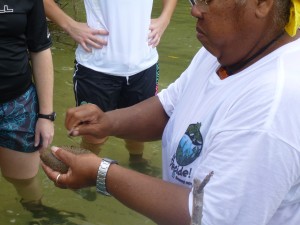Today started out much like the others. Many of us, still adjusting to the time difference, woke up well before we needed to be ready. We trotted down the staircase, bags in hand, to head to our village stay. Rebecca was the leader as we traveled through downtown Koror and on the main highway to our destination, Ollei. A little over an hour into the trip (and apparently after Lisa had been honking and flashing her lights for 10 minutes or so), Rebecca noticed Lisa’s van pulling over. We stopped and after a brief chat realized that we may have missed the turn. We continued on our journey for another 15 minutes or so, venturing back the way we came, until we reached our turn and finally our destination. We were welcomed by Ann (our friendly and enthusiastic guide and good friend of Rebecca’s) and quickly moved into our new home:
We changed into our swimsuits and split into groups of six to go out for our morning activities. We had a choice of clamming in the mangroves or sea cucumber gleaning on the coastline. The clam group explained that they went out by boat and jumped out into the mangroves. They were chest deep in silt filled water and used their toes to pick up clams. Most of the clams harvested ranged from the size of a quarter to the size of a baby’s hand. Our group set out to fish for sea cucumbers. We kayaked out with two local ladies from the village and set up on a beach not too far away from town. We started digging through the sand right on the edge of the water. The ladies informed us that this is where little clams can be found. We were to collect these little clams to help flavor our dinner, clam soup. It was explained to us that the clams suction the water through their shells and you can find them if you look for their “eyes”. The term “eye” of the clam is a Palauan description and is defined as the area where the sand is indented due to the suction produced by the clam. It is easy to see this indentation from the water. If you dig just below the indentation, you will always find a clam.
Following our harvest for clam soup, we stepped out into the ocean to find some sea cucumbers. To fish for sea cucumber we walked straight out into waist deep waters and walked around in the sea grass. Anytime you felt something particularly slimy, it was likely a sea cucumber. In total, we found 3 different kinds:
This one you only eat the intestines of. The ladies explained that it is best to harvest these in the early morning before they have eaten. If you reach them too late in the day, they will have eaten and their intestines will be full of sand particles. Many of us were saddened that only a small part of the animal harvested would be used for food, however, the ladies informed us that sea cucumbers can heal themselves and grow a new intestinal track.
The other two were more solid in color. One you had to scrape the skin off of and you could eat the flesh. The other was a solid black color that the people of Ollei do not eat. Chase was the sea cucumber whisperer and caught almost half of the ones that we were able to bring back to the village. After our hard work, we were very tired and paddled back to the mainland for lunch.
After lunch, it was time to go line fishing. We set out to the harbor and prepared to get on Tino’s boat. When we arrived, we were informed that Ann had tied the boat up and somehow it had come untied. It was very far off the coast and one of the other men in the village had gone out to retrieve it. While we could barely see his boat (now a speck) on the horizon, we hoped that he was successful! One of the senior women in the village explained that this experience was why Palauans always say to tie five knots at a time. This way, if the first knot doesn’t hold, the next one will.
To pass the time we had two discussions with the local fishermen. Tino spoke to us about the history of spawning and how the lunar cycle is used to describe a fishes spawning patterns. Saiky spoke about fishing in the village and the Marine Protected Area (MPA). This talk was focused on the laws that exist to prevent other villages from fishing in these waters.
After about an hour the boat was back and we broke up again into two groups. One group went back and prepared the coconuts for our dinner, while the other group went out to fish. A storm was headed for Palau and the sea was rather rough. Our fishing lines were attached to old beer and soda bottles, with hooks and sardines on the end of each line:
Unfortunately, after an hour or so, we had caught nothing. While our fishing capabilities were sub-par, we were able to learn a few Palauan weather legends. For instance, “if a spider outside of your house packs up it’s web and disappears, a storm is coming.” In addition, “If a dog or cat is drinking a puddle outside, it is going to be hot the next day.” Feeling ashamed that we were unable to catch dinner, we headed back in to help cook the clam soup:
Finally, we ended the night with a lecture about fishing from one of the oldest fishermen in the village, Arturvi Catusis Kang. Today was quite busy so it was no surprise that we all fell asleep before the clock struck 9. What a wonderful introduction to an amazing village!





